Caledonian MacBrayne
Caledonian MacBrayne (Scottish Gaelic: Caledonian Mac a' Bhriuthainn), usually shortened to CalMac, is the major operator of passenger and vehicle ferries, and ferry services, between the mainland of Scotland and 22 of the major islands on Scotland's west coast. Since 2006 the company's official name has been CalMac Ferries Ltd although it still operates as Caledonian MacBrayne. In 2006 it also became a subsidiary of holding company David MacBrayne Ltd, which is owned by the Scottish Government.[2]
| Caledonian MacBrayne | |
| Government-owned service | |
| Industry | Transport |
| Predecessor | Caledonian Steam Packet Company, David MacBrayne Ltd |
| Founded | 1851 |
| Founder | David MacBrayne |
| Headquarters | Gourock, Scotland, UK[1] |
Area served | Firth of Clyde, Outer Hebrides, Inner Hebrides |
Key people | Robbie Drummond (Managing Director) |
| Services | Ferries |
| Owner | Scottish Government |
| Parent | David MacBrayne Ltd |
| Divisions | Argyll Ferries |
| Website | www |
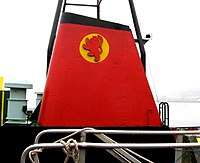
History
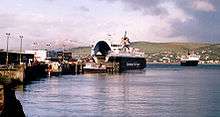
David MacBrayne
MacBrayne's, initially known as David Hutcheson & Co., began in 1851 as a private steamship operator when G. and J. Burns, operators of the largest of the Clyde fleets, decided to concentrate on coastal and transatlantic services and handed control of their river and Highland steamers to a new company in which Hutcheson, their manager of these services, became senior partner. Their main route went from Glasgow down the Firth of Clyde through the Crinan Canal to Oban and Fort William, and on through the Caledonian Canal to Inverness. David Hutcheson was married to Margaret Dawson who was born at her parents home 'Bonnytoun House' in Linlithgow. She was the sister of Adam Dawson who owned the St. Magdalene Whisky Distillery in Linlithgow and sister to James Dawson who were also born at 'Bonnytoun House'. In 2011 Glasgow historian Robert Pool added over 200 letters and documents to his collection relating to David Hutcheson and the Dawson family.[3]
Caledonian Steam Packet Company
The Caledonian Railway at first used the services of various early private operators of Clyde steamers, then began operating steamers on its own account on 1 January 1889 to compete better with the North British Railway and the Glasgow and South Western Railway. It extended its line to bypass the G&SW's Prince's Pier at Greenock and continue on to the fishing village of Gourock, where they had purchased the harbour.
After years of fierce competition between all the fleets, the Caledonian and G&SW were merged in 1923 into the London, Midland and Scottish Railway (LMS) and their fleets were amalgamated into the Caledonian Steam Packet Company. Their funnels were painted yellow with a black top. At the same time the North British Railway fleet became part of the London and North Eastern Railway (which built the PS Waverley in 1947). With nationalisation in 1948 the LMS and LNER fleets were amalgamated under British Railways with the name Clyde Shipping Services. In 1957 a reorganisation restored the CSP name, and in 1965 a red lion was added to each side of the black-topped yellow funnels. The headquarters remained at Gourock pierhead.
At the end of December 1968 management of the CSP passed to the Scottish Transport Group, which gained control of MacBrayne's the following June. The MacBrayne service from Gourock to Ardrishaig ended on 30 September 1969, leaving the Clyde entirely to the CSP.
Caledonian MacBrayne
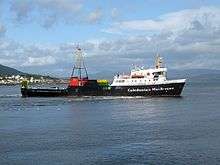
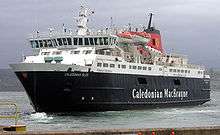
On 1 January 1973 the Caledonian Steam Packet Co. acquired most of the ships and routes of MacBrayne's and commenced joint Clyde and West Highland operations under the new name of Caledonian MacBrayne, with a combined headquarters at Gourock. Funnels were now painted red with a black top, and a yellow circle at the side of the funnel featuring the red Caledonian lion. In 1974 a new car ferry service from Gourock to Dunoon was introduced with the ferries MV Jupiter and MV Juno.
In 1990 the ferry business was spun off as a separate company, keeping the Caledonian MacBrayne brand, and shares were issued in the company. All shares were owned by the state, first in the person of the Secretary of State for Scotland, and (after devolution) by the Scottish Government.
A joint venture between Caledonian MacBrayne and the Royal Bank of Scotland named NorthLink Orkney and Shetland Ferries won the tender for the subsidised Northern Isles services, previously run by P&O Scottish Ferries, commencing in 2002. The ambitious programme ran into financial difficulties, and the service was again put out to tender. Caledonian MacBrayne won this tender, and formed a separate company called NorthLink Ferries Limited which began operating the Northern Isles ferry service on 6 July 2006.[4] On 29 May 2012, NorthLink Ferries Ltd lost the contract for provision of the Northern Isles ferry services to Serco.[5]
Restructuring
To meet the requirements of European Union Community guidelines on state aid to maritime transport, the company's routes were put out to open tender. To enable competitive bidding on an equal basis, Caledonian MacBrayne was split into two separate companies on 1 October 2006. Caledonian Maritime Assets Limited (CMAL) retained ownership of CalMac vessels and infrastructure, including harbours, while CalMac Ferries Ltd submitted tenders to be the ferry operator. Their bid for the main bundle, Clyde and Hebrides Ferry Services, succeeded and on 1 October 2007 CalMac Ferries Ltd began operating these services on a six-year contract. The Gourock to Dunoon service was the subject of a separate tender, but no formal bids were made. In an interim arrangement CalMac Ferries Ltd continued to provide a subsidised service on this route,[4][6] until 29 June 2011, when Argyll Ferries took over the service.
On 14 July 2009, it was announced that CalMac would begin Sunday sailings to Stornoway on Lewis from Sunday 19 July. These had historically faced strong opposition from Sabbatarian elements in the Lewis community, particularly the Lord's Day Observance Society and the Free Church of Scotland. However, CalMac stated that EU equality legislation made it unlawful to refuse a service to the whole community because of the religious beliefs of a part of it.[7]
Business
The company enjoys a de facto monopoly on the shipment of freight and vehicles to the islands, and competes for passenger traffic with a number of aircraft services of varying quality and reliability. Nonetheless, few if any of the routes currently operated by CalMac are profitable, and the company receives significant government subsidies due to its vital role in supplying the islands: these routes are classified as "lifeline" services. In 1996 CalMac opened its first route outside Scotland, winning a ten-year contract to provide a lifeline service to Rathlin Island in Northern Ireland. This service continued until 2008 when CalMac lost the tender.[8]
Various versions of a local poem (based loosely on Psalm 24) refer to MacBrayne's long dominance of Hebridean sailings:
The Earth belongs unto the Lord
And all that it contains
Except the Kyles and the Western Isles
And they are all MacBrayne's
Several groups have proposed privatising the service, and there has been a long commercial and political struggle with a privately owned company, Western Ferries, which has run a rival unsubsidised service from Gourock to Hunters Quay (near Dunoon) since 1973. In 2005, the Scottish Executive put the collective Hebrides routes out to competitive tender, with the Dunoon route being a separate tender.[9] Some island and union groups opposed the tendering process, fearing it would lead to cuts in services and could be a prelude to full privatisation.
During the tendering period, the company of David MacBrayne Ltd., which had been legally dormant for many years, was re-activated on 4 July 2006. David MacBrayne Group Ltd. acquired the full share capital of NorthLink Ferries Ltd, and took over operations of the NorthLink routes on 6 July 2006. Three operators submitted bids for the block of routes,[10] but CalMac retained all its existing routes. During September 2006, David MacBrayne Group Ltd. acquired the entire share capital of CalMac Ferries Ltd. Thus, from leaving the hands of David MacBrayne 78 years earlier in 1928, the west coast ferry service returned to the fold in 2006, vastly enlarged.
At the time, no bids were made for the separate Gourock–Dunoon route and the service continued as before. In August 2006, David MacBrayne Group Ltd. directed two of its subsidiary companies, Cowal Ferries Ltd. and Rathlin Ferries Ltd., to take over operation of the Gourock to Dunoon, and Rathlin to Ballycastle services. Following a European Commission decision not to subsidise a passenger and vehicle service, the route was again put out to tender. In May 2011, Argyll Ferries Ltd, a newly formed subsidiary of David MacBrayne, was named as the preferred bidder for a passenger-only Dunoon-Gourock service. The timetable was extended into the early hours at weekends, with additional sailings integrated with rail services. Two passenger-only ferries, MV Ali Cat and MV Argyll Flyer (formerly MV Banrion Chonomara), were arranged for the run.[11] When the service began on 30 June 2011, preparation of the Argyll Flyer was incomplete, and as an interim measure the cruise boat MV Clyde Clipper was leased from Clyde Cruises.[12]
Argyll Ferries was incorporated into Caledonian MacBrayne on 21 January 2019.[13]
Routes
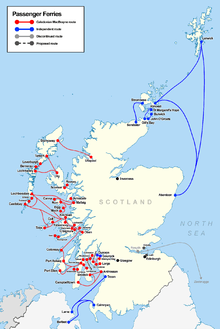
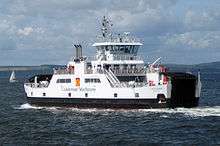
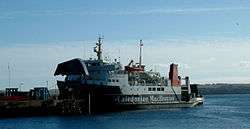
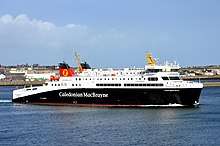
Other vessels
- MV Loch Bhrusda & MV Loch Linnhe are spare and relief vessels.
Two new dual fuel ferries are being built by Ferguson Marine Engineering.[14]
Emergency lifeline timetable
During the COVID-19 pandemic, CalMac operated a much reduced timetable. From Sunday 22 March 2020, they provided a turn up and go service to ensure essential goods and services were delivered to the islands. There were no reservations and no onboard retail facilities. Timetables were modified to meet local needs, with occasional additional crossings and extended layovers.[20]
The Portavadie, Campbeltown and Armadale services were cancelled. Crossing frequencies were reduced on other routes, with single vessels at Rothesay, Largs and Kennacraig.[21] On the smaller vessels, vehicle occupants were required to remain in their vehicle.[22]
Until Hebrides returned from dry dock in Liverpool, Clansman remained on the Uig triangle, with Lord of the Isles and Isle of Arran providing services to Lochboisdale, Coll/Tiree and Colonsay from Oban. Hebridean Isles operated to Arran (22 April – 2 May) and Islay (27 May – 2 June) while Caledonian Isles and Finlaggan were out of service.[23]
Unused vessels were laid up: Hebridean Isles in Campbeltown; Coruisk at Craignure; Loch Riddon, Loch Linnhe and Loch Fyne at Sandbank; Loch Bhrusda in Mallaig (covered Sound of Barra service while Loch Alainn in Troon); Argyle and Isle of Cumbrae in Rothesay and Isle of Arran in Troon.[23]
Passenger numbers
| Route | 2017 | 2016 | Change (2016–17) | % change | 2014 | 2006 |
|---|---|---|---|---|---|---|
| Ardrossan–Brodick | 844,198 | 828,262 | 715,048 | 735,928 | ||
| Largs–Cumbrae | 745,619 | 738,549 | 706,172 | 722,561 | ||
| Wemyss Bay/Gourock–Rothesay | 713,906 | 675,714 | 674,088 | 759,680 | ||
| Oban–Craignure | 670,248 | 644,827 | 572,084 | 640,426 | ||
| Mallaig–Armadale | 285,483 | 250,764 | 239,453 | 188,929 | ||
| Ullapool–Stornoway | 275,699 | 264,055 | 226,061 | 181,160 | ||
| Fionnphort–Iona | 250,311 | 243,211 | 223,978 | 255,501 | ||
| Colintraive–Rhubodach | 216,204 | 232,015 | 214,550 | 264,644 | ||
| Kennacraig–Islay | 214,334 | 203,219 | 189,822 | 152,526 | ||
| Uig–Tarbert/Lochmaddy | 195,752 | 188,138 | 194,416 | 148,587 |
Current fleet
Vessels are owned by Caledonian Maritime Assets Ltd (CMAL) and operated by CalMac Ferries Ltd. There are 34 vessels in current service, with ten "major units" – ships of 80 m (262 ft) or more in length. The largest is MV Loch Seaforth at 116 m (381 ft) in length. MV Finlaggan is almost 90 m (295 ft) long and able to carry 550 passengers with 88 cars.[25] She was built in Poland at a cost of £24.5 million and operates the Islay service.[26] The others are MV Isle of Lewis, MV Clansman, MV Hebrides, MV Caledonian Isles, MV Isle of Mull, MV Hebridean Isles, MV Isle of Arran and MV Lord of the Isles.[25]
There are 13 "Loch Class" vessels in different shapes and sizes. These double-ended ferries are mostly symmetrical when viewed from the side, with no operational bow or stern (although in official documents the designation of such is given). MV Loch Portain is able to handle Force 7 gales and carry 36 cars and 149 passengers, with a crew of five. The smallest vessel in the fleet is MV Carvoria, built in Shetland for the Kerrera route.[27] From June 2020, CalMac lease MV Chieftain from Clyde Marine Services for the Gourock to Kilcreggan service.[28]
The company is adapting to the demands of 21st century. MV Lochnevis (2000) was designed for the Small Isles service. MV Bute (2005) and MV Argyle (2007), both built in Gdańsk, are on the Wemyss Bay–Rothesay route. A new "super loch", MV Loch Shira, entered service in 2007 on the Largs–Cumbrae route. MV Hallaig (2013; for Raasay), MV Lochinvar (2013; for Tarbert) and MV Catriona (2015; for Lochranza), built by Ferguson Marine Engineering are pioneering seagoing roll-on roll-off vehicle and passenger diesel-electric hybrid ferries.[29] The latest vessels are two dual fuel ferries under construction by Ferguson Marine Engineering. Glen Sannox (for the Arran service[30]) was launched on 21 November 2017[31] and is now due to be delivered in the last quarter of 2021.[18] Launch of Hull 802 (for the Uig triangle[30]) has been delayed.[18]
References
Notes
- https://beta.companieshouse.gov.uk/company/SC302282
- "Company History". Caledonian MacBrayne.
- "David Hutcheson and Dawson family documents". The Great Shipping Dynasty of Burns, Hutcheson and MacBrayne. Robert Pool's Glasgow Collection @ Flickr. June 2011. Retrieved 11 April 2013.
- Alan Rehfisch (2007). "Ferry Services in Scotland" (PDF). SPICe Briefing. Scottish Parliament Information Centre. Retrieved 16 January 2015.
- "Serco confirmed as Northern Isles ferry operator". BBC News. 29 May 2012. Retrieved 25 July 2012.
- "UK | Scotland | Highlands and Islands | CalMac ferry contract confirmed". BBC News. 20 September 2007. Retrieved 10 November 2011.
- "UK | Scotland | Highlands and Islands | Green light for Sunday sailings". BBC News. 14 July 2009. Retrieved 10 November 2011.
- "Probe into tendering contract of ferry run". News Letter. 17 June 2008.
- "Proposals for Gourock-Dunoon ferry route". Scottish Executive. 21 September 2005. Retrieved 29 August 2007.
- "UK | Scotland | Contest narrows for CalMac routes". BBC News. 23 December 2005. Retrieved 10 November 2011.
- "Argyll News: Argyll Ferries Wins Dunoon-Gourock Ferry Tender". For Argyll. 26 May 2011. Retrieved 10 November 2011.
- Goodwin, David (1 July 2011). "Ferry Launch is hit by first-day breakdown". Greenock Telegraph. pp. 1–2.
- "CalMac takes over the tiller at Argyll Ferries". Argyll Ferries. 21 January 2019. Archived from the original on 27 January 2019. Retrieved 27 January 2019.
- "Caledonian Maritime Assets Limited announces Scottish shipbuilder as preferred tenderer for two large ferries contract". CMAL. 31 August 2015. Retrieved 24 June 2017.
- "Costs double on delayed CalMac ferry contract". BBC News. 18 December 2019. Retrieved 14 January 2020.
- "Ferguson Marine update". Scottish Government. 18 December 2019. Retrieved 14 January 2020.
- "CMAL announces name of first LNG ferry". CMAL. 1 June 2017. Retrieved 24 June 2017.
- Ferguson Marine: report on cost and programme for vessels 801 and 802, Scottish Goverenment, 9 December 2019, retrieved 23 December 2019
- "Public invited to help name CMAL's first LNG ferry". CMAL. 2 May 2017. Retrieved 24 June 2017.
- "Statement from Transport Scotland on restrictions on non-essential ferry travel". CalMac. 24 March 2020. Retrieved 13 June 2020.
- "CalMac introduces Essential Lifeline Timetable in light of Covid-19 outbreak". CalMac. Retrieved 13 June 2020.
- "Travel Advice" (pdf). CalMac. Retrieved 24 June 2020.
- "Live Map". Marine Traffic.
- "Carrying Statistics". Calmac.co.uk. Retrieved 16 August 2018.
- "Ships of the Fleet". Ships of CalMac. Retrieved 10 November 2011.
- "Remontowa wins newbuilding order for another ferry to be operated by CalMac Ferries Ltd". Remontowa.net. 2 November 2007. Archived from the original on 4 October 2011. Retrieved 10 November 2011.
- "New Kerrera Ferry Launches in Lerwick". CMAL. 15 August 2017. Retrieved 23 April 2018.
- Craig Borland (8 May 2020). "CalMac to take over Gourock-Kilcreggan ferry next month". Helensburgh Advertiser. Retrieved 12 June 2020.
- "'Hybrid' CalMac ferry launched from Port Glasgow". BBC News. 17 December 2012. Retrieved 13 January 2013.
- "CMAL Shares Project Update on Dual Fuel Ferries". CMAL. 9 March 2017. Retrieved 25 November 2017.
- "First Minister Launches UK's First LNG Ferry". CMAL. 21 November 2017. Retrieved 25 November 2017.
Bibliography
- McCrorie, Ian (1987). Clyde Pleasure Steamers: an illustrated history. Greenock: Orr, Pollock & Co. ISBN 978-1-869850-00-5.
- McCrorie, Ian (1987). Steamers of the Highlands and Islands: an illustrated history. Greenock: Orr, Pollock & Co. ISBN 978-1-869850-01-2.
- McCrorie, Ian (1989). To the Coast: one hundred years of the Caledonian Steam Packet Company. Fairlie: Fairlie Press. ISBN 978-1-871209-01-3.
- Meek, Donald E.; Peter, Bruce (2011). From Comet to Cal Mac: Two Centuries of Hebridean and Clyde Shipping. Ramsey, Isle of Man: Ferry Publications. ISBN 9781906608361.
- Preston, Robert (1994). Days at the Coast. Ochiltree: Stenlake Publishing. ISBN 978-1-872074-42-9.
- Robins, Nick S.; Meek, Donald E. (2006). The Kingdom of MacBrayne: from steamships to car-ferries in the West Highlands and Hebrides, 1820-2005. Edinburgh: Birlinn. ISBN 978-1-84158-500-0.
- Smith, Colin; Cowsill, Miles (2016). Caledonian MacBrayne Hebridean and Clyde Ferries: the fleet. Ramsey, Isle of Man: Ferry Publications. ISBN 9781911268055.
External links
| Wikimedia Commons has media related to Caledonian MacBrayne. |